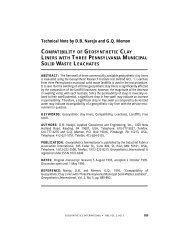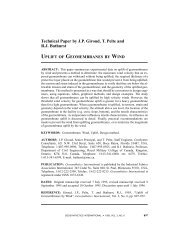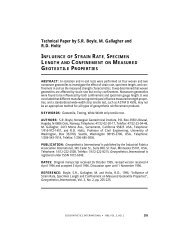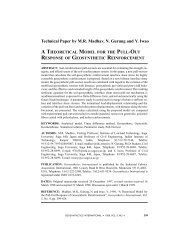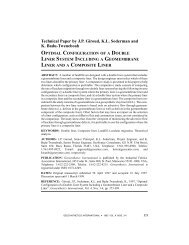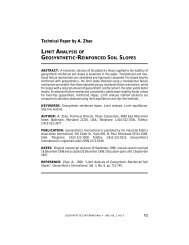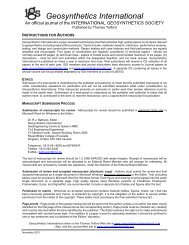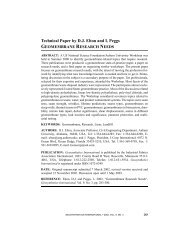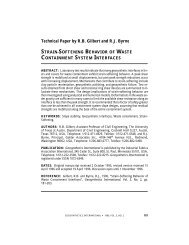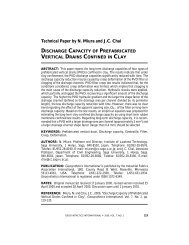modelling geosynthetic-reinforced granular fills over soft soil - IGS ...
modelling geosynthetic-reinforced granular fills over soft soil - IGS ...
modelling geosynthetic-reinforced granular fills over soft soil - IGS ...
You also want an ePaper? Increase the reach of your titles
YUMPU automatically turns print PDFs into web optimized ePapers that Google loves.
Technical Paper by J.H. Yin<br />
MODELLING GEOSYNTHETIC-REINFORCED<br />
GRANULAR FILLS OVER SOFT SOIL<br />
ABSTRACT: In this paper, a new one-dimensional mathematical model is proposed<br />
for <strong>modelling</strong> <strong>geosynthetic</strong>-<strong>reinforced</strong> <strong>granular</strong> <strong>fills</strong> <strong>over</strong> <strong>soft</strong> <strong>soil</strong>s subject to a vertical<br />
surcharge load. The <strong>geosynthetic</strong> reinforcement consists of a membrane (geogrid, or<br />
geotextile) placed horizontally in engineered <strong>granular</strong> fill, which is constructed <strong>over</strong><br />
<strong>soft</strong> <strong>soil</strong>. The proposed model is mainly based on the assumption of a Pasternak shear<br />
layer. A new approach that consists of incorporating a deformation compatibility condition<br />
into the model is introduced. The compatibility condition eliminates the need for<br />
two uncertain model parameters that are required to calculate the shear stresses between<br />
the top and bottom <strong>granular</strong> fill layers and the <strong>geosynthetic</strong> layer. This compatibility<br />
condition also makes it possible to include the <strong>geosynthetic</strong> stiffness in the model. The<br />
results from the proposed model are compared to results from a two-dimensional finite<br />
element model and three other one-dimensional models reported in the literature. The<br />
comparison reveals that the proposed model gives similar results with respect to the<br />
settlement of a <strong>geosynthetic</strong>-<strong>reinforced</strong> <strong>granular</strong> base on <strong>soft</strong> <strong>soft</strong> and the mobilised tension<br />
in the <strong>geosynthetic</strong> layer.<br />
KEYWORDS: Geosynthetic reinforcement, Soil improvement, Foundation model,<br />
Settlement, Tension force, Finite element <strong>modelling</strong>.<br />
AUTHOR: J.H. Yin, Assistant Professor, The Department of Civil and Structural<br />
Engineering, The Hong Kong Polytechnic University, Hung Hom, Kowloon, Hong<br />
Kong, Telephone: 852/2766-6065, Telefax: 852/2334-6389, E-mail:<br />
cejhyin@polyu.edu.hk.<br />
PUBLICATION: Geosynthetics International is published by the Industrial Fabrics<br />
Association International, 345 Cedar St., Suite 800, St. Paul, Minnesota 55101-1088,<br />
USA, Telephone: 1/612-222-2508, Telefax: 1/612-222-8215. Geosynthetics<br />
International is registered under ISSN 1072-6349.<br />
DATES: Original manuscript received 16 December 1996, revised version received<br />
14 March 1997 and accepted 11 April 1997. Discussion open until 1 January 1998.<br />
REFERENCE: Yin, J.H., 1997, “Modelling Geosynthetic-Reinforced Granular Fills<br />
Over Soft Soil”, Geosynthetics International, Vol. 4, No. 2, pp. 165-185.<br />
GEOSYNTHETICS INTERNATIONAL S 1997, VOL. 4, NO. 2<br />
165
YIN D Modelling Geosynthetic-Reinforced Granular Fills Over Soft Soil<br />
1 INTRODUCTION<br />
A foundation constructed on <strong>soft</strong> <strong>soil</strong>s may experience excessive settlement and possible<br />
bearing capacity failure under a surcharge load. One technique that is used to improve<br />
the strength of <strong>soft</strong> foundation <strong>soil</strong>s is the placement of engineered <strong>granular</strong> <strong>fills</strong><br />
containing <strong>geosynthetic</strong> reinforcement (e.g. geogrid, or geotextile) on the <strong>soft</strong> <strong>soil</strong>. The<br />
calculation of settlement and the ultimate bearing capacity of the <strong>geosynthetic</strong>-<strong>reinforced</strong><br />
<strong>granular</strong> fill <strong>over</strong> <strong>soft</strong> <strong>soil</strong> is an important issue facing design engineers. This paper<br />
is focussed on the <strong>modelling</strong> of the load-settlement behaviour of <strong>geosynthetic</strong>-<strong>reinforced</strong><br />
<strong>granular</strong> fill <strong>over</strong> <strong>soft</strong> <strong>soil</strong>. Various works have been carried out by many<br />
researchers in this area of study (Bourdeau et al. 1982; Love et al. 1987; Madhav and<br />
Poorooshasb 1988; Bourdeau 1989; Poorooshasb 1989; Poran et al. 1989; Ghosh 1991;<br />
Poorooshasb 1991; Espinoza 1994; Ghosh and Madhav 1994; Khing et al. 1994; Shukla<br />
and Chandra 1994; Shukla and Chandra 1995). In these <strong>modelling</strong> approaches, a twodimensional<br />
(2-D) plane strain problem (e.g. a strip footing) is simplified to a one-dimensional<br />
(1-D) problem. In the 1-D model, the <strong>soft</strong> <strong>soil</strong> is represented by Winkler<br />
springs, the behaviour of which may be linear or nonlinear. The top and the bottom <strong>granular</strong><br />
fill layers are assumed to behave as Pasternak shear layers (Pasternak 1954). The<br />
<strong>geosynthetic</strong> layer (“membrane”) buried in the <strong>granular</strong> fill can withstand tension<br />
forces only, and the <strong>geosynthetic</strong> layer behaviour is assumed to be elastic. This 1-D<br />
model has an inherent problem, as does the Winkler foundation model, because no interaction<br />
between the springs is considered. However, as pointed out by Shukla and<br />
Chandra (1995), the interaction of the springs is not very significant for highly compressible<br />
<strong>soft</strong> <strong>soil</strong>s.<br />
In most existing models, the longitudinal stiffness of the <strong>geosynthetic</strong> layer is assumed<br />
to be rigid in tension, but does not carry vertical shear forces (Ghosh and Madhav<br />
1994; Shukla and Chandra 1994; Shukla and Chandra 1995). The shear stresses acting<br />
on the top and bottom surfaces of the <strong>geosynthetic</strong> layer are assumed to be related to<br />
the vertical stresses acting on the top and bottom surfaces by a constant that is defined<br />
by μ in the following expression: τ = μσ ,whereτ = shear stress and σ = vertical stress<br />
(Ghosh and Madhav 1994; Shukla and Chandra 1994; Shukla and Chandra 1995). The<br />
magnitude of the constant μ is not exactly known which may cause difficulties when<br />
using most existing models.<br />
In this paper, a deformation compatibility condition is proposed. The use of this compatibility<br />
condition eliminates the two uncertain constants defined by μ for the top and<br />
bottom shear stresses acting on the <strong>geosynthetic</strong> layer. The tension stiffness modulus<br />
of the <strong>geosynthetic</strong> layer is incorporated into the proposed new model. In the first step<br />
of model development, the behaviour of the <strong>granular</strong> fill is assumed to be elastic (Shukla<br />
and Chandra 1995). The nonlinear and elastic-plastic behaviour of the <strong>granular</strong> fill<br />
can be considered using the method proposed in this paper. In order to validate the proposed<br />
model against other models, the results from the proposed model are compared<br />
to two-dimensional FE <strong>modelling</strong> results and the results from other one-dimensional<br />
models.<br />
166 GEOSYNTHETICS INTERNATIONAL S 1997, VOL. 4, NO. 2
YIN D Modelling Geosynthetic-Reinforced Granular Fills Over Soft Soil<br />
2 FORMULATION OF THE PROPOSED ONE-DIMENSIONAL MODEL<br />
Figure 1 shows a simplified foundation model for a <strong>geosynthetic</strong> (e.g. geogrid, or geotextile)<br />
<strong>reinforced</strong> <strong>granular</strong> fill <strong>over</strong> <strong>soft</strong> <strong>soil</strong>. This simplified model is similar to the<br />
model proposed by Shukla and Chandra (1995). According to the assumption of a Pasternak<br />
shear layer, vertical planes in the <strong>granular</strong> fill layer move relative to each other<br />
only in the vertical direction without rotation. The interface between the <strong>geosynthetic</strong><br />
layer (“membrane”) and the two <strong>granular</strong> fill layers is assumed to be fixed (i.e. there<br />
is rough contact and no slippage). In this study, the behaviour of the <strong>granular</strong> fill and<br />
the <strong>geosynthetic</strong> layer is assumed to be elastic.<br />
The proposed model can be a simplification of a strip footing (or other similar structures)<br />
on a <strong>geosynthetic</strong>-<strong>reinforced</strong> <strong>granular</strong> fill <strong>over</strong> <strong>soft</strong> <strong>soil</strong>. The strip footing load is<br />
simplified as a vertical pressure loading boundary of width 2B (Figure 1). Considering<br />
a unit length in the direction perpendicular to Figure 1, the vertical force equilibrium<br />
for Element 1 in Figure 2 (top <strong>granular</strong> fill layer) leads to the following expression:<br />
qdx − σ n dl cos θ + τ n dl sin θ + dτ<br />
dx dxH t = 0<br />
(1)<br />
where: q = footing pressure on the top <strong>granular</strong> fill layer; dx = projected element length<br />
in the x direction; σ n = average normal stress acting on the bottom of the element; τ n =<br />
average shear stress acting on the bottom of the element; dl = length of the bottom of<br />
the element as shown in Figures 2 and 4; θ = angle between the horizontal and the bottom<br />
of the element; H t = thickness of the top <strong>granular</strong> fill layer; and τ = average shear<br />
stress acting on the side of the element.<br />
According to the assumption of a Pasternak shear layer, the average vertical shear<br />
stress is τ =G t dw/dx, anddτ/dx =G t d 2 w/dx 2 ,whereG t is the average shear modulus<br />
of the top <strong>granular</strong> fill layer, and w is the vertical displacement. Thus, Equation<br />
1 can be written as follows:<br />
2B<br />
q<br />
Pasternak shear layers<br />
H t<br />
G t for top <strong>granular</strong> fill layer<br />
E g for <strong>geosynthetic</strong> layer<br />
T, T p “membrane”<br />
T, T p<br />
H b<br />
G b for bottom <strong>granular</strong> fill layer<br />
k s<br />
Soft <strong>soil</strong><br />
Bedrock<br />
Figure 1. Schematic diagram of the proposed one-dimensional foundation model, and the<br />
definition of model parameters.<br />
GEOSYNTHETICS INTERNATIONAL S 1997, VOL. 4, NO. 2<br />
167
YIN D Modelling Geosynthetic-Reinforced Granular Fills Over Soft Soil<br />
(a)<br />
Element 1<br />
w<br />
dx<br />
q<br />
w +dw<br />
x<br />
τ<br />
τ + (∂τ/∂x)dx<br />
(b)<br />
Element 2<br />
T p ,T<br />
θ<br />
σ n<br />
τ n<br />
τ n<br />
σ n<br />
(c)<br />
Element 3<br />
τi n<br />
σi n<br />
σi n<br />
τi n<br />
θ + dθ<br />
T p ,T+dT<br />
y<br />
τi<br />
dl<br />
τi + (∂τi/∂x)dx<br />
q s =k s w<br />
Figure 2. Three elements from a vertical segment of a <strong>geosynthetic</strong>-<strong>reinforced</strong> <strong>granular</strong> fill<br />
of infinitesimal width showing the forces and stresses on each element: (a) top <strong>granular</strong> fill<br />
layer; (b) <strong>geosynthetic</strong> layer; (c) bottom <strong>granular</strong> fill layer.<br />
q = σ n − τ n tan θ − H t G t<br />
d 2 w<br />
dx 2<br />
(2)<br />
where q = 0 outside of the loaded area.<br />
The vertical force equilibrium equation for Element 3 (bottom <strong>granular</strong> fill layer) in<br />
Figure 2c is expressed as follows:<br />
− q s dx + σ ′ n dl cos θ − σ ′ n dl sin θ + dτ′<br />
dx dxH b = 0<br />
(3)<br />
where: q s = vertical reaction pressure of <strong>soft</strong> <strong>soil</strong> (simplified as Winkler springs); σ′ n =<br />
average normal stress acting on the top of the element; τ′ n = average shear stress acting<br />
on the top of the element; H b = thickness of the bottom <strong>granular</strong> fill layer; and τ′=aver-<br />
168 GEOSYNTHETICS INTERNATIONAL S 1997, VOL. 4, NO. 2
YIN D Modelling Geosynthetic-Reinforced Granular Fills Over Soft Soil<br />
age shear stress acting on the side of the bottom element. Substituting τ′ =G b dw/dx,<br />
and dτ′/dx =G b d 2 w/dx 2 , Equation 3 becomes:<br />
q s = σ ′ n − τ ′ n tan θ − H b G b<br />
d 2 w<br />
dx 2<br />
(4)<br />
where G b is the average shear modulus of the bottom <strong>granular</strong> fill layer.<br />
The vertical force equilibrium equation for Element 2 in Figure 2b (<strong>geosynthetic</strong> layer)<br />
leads to the following expression:<br />
dT<br />
dx sin θ =−(T + T p)cosθ dθ<br />
dx − (σ n − σ ′ n) + (τ n + τ ′ n)tanθ<br />
(5)<br />
where: T = mobilised tension in the <strong>geosynthetic</strong> layer; and T p = pretension force of the<br />
<strong>geosynthetic</strong> layer.<br />
The horizontal force equilibrium equation for Element 2 (<strong>geosynthetic</strong> layer) is expressed<br />
as follows:<br />
dT<br />
dx cos θ = (T + T p)sinθ dθ<br />
dx + (σ n − σ ′ n)tanθ + (τ n + τ ′ n)<br />
(6)<br />
Figure 3 shows the deformation of the top and bottom <strong>granular</strong> fill elements due to<br />
an increase in tension, dT. Assuming no sliding between the <strong>geosynthetic</strong> layer and the<br />
top and bottom <strong>granular</strong> fill layers, the following deformation compatibility condition<br />
(or relationships) exists:<br />
u x = u ′ x = u g,x<br />
(7)<br />
where u x ,u′ x and u g,x are the horizontal displacements at the top and bottom <strong>granular</strong><br />
fill layers, and the interface of the <strong>geosynthetic</strong> layer, respectively.<br />
The values of u x and u′ x are related to the shear strain values, γ x and γ′ x , respectively,<br />
which are then related to the shear stresses, τ n and τ′ n , as expressed in the following:<br />
u x = H t γ x = H t<br />
τ n<br />
(8)<br />
u ′ x = H b γ ′ x = H b<br />
τ ′ n<br />
G b<br />
G t<br />
(9)<br />
Using Equations 7 to 9, the shear stress, τ n , can be expressed in terms of τ′ n as follows:<br />
τ n = G t H b<br />
G b H t<br />
τ ′ n<br />
(10)<br />
Figure 4 shows a stretched and rotated element of the <strong>geosynthetic</strong> layer. Using Equations<br />
7 to 9, the displacement of the <strong>geosynthetic</strong> element and the displacement increment<br />
can be written as follows:<br />
GEOSYNTHETICS INTERNATIONAL S 1997, VOL. 4, NO. 2<br />
169
YIN D Modelling Geosynthetic-Reinforced Granular Fills Over Soft Soil<br />
dx<br />
x<br />
(a)<br />
Element 1<br />
γ x<br />
G t<br />
H t<br />
(b)<br />
Element 2<br />
T p ,T<br />
u x<br />
σ n<br />
τ n<br />
τ<br />
σ n n<br />
τi n σi n<br />
τi n<br />
T p ,T+dT<br />
(c)<br />
Element 3<br />
ui x<br />
σi n<br />
γi x<br />
G b<br />
H b<br />
y<br />
Figure 3. Shear deformation due to an increase in <strong>geosynthetic</strong> layer mobilised tension:<br />
(a) top <strong>granular</strong> fill layer; (b) <strong>geosynthetic</strong> layer; (c) bottom <strong>granular</strong> fill layer.<br />
dx<br />
u g,x<br />
u g,x + du g,x<br />
θ<br />
dw<br />
dl<br />
Figure 4.<br />
Stretching and rotation of a <strong>geosynthetic</strong> element.<br />
170 GEOSYNTHETICS INTERNATIONAL S 1997, VOL. 4, NO. 2
YIN D Modelling Geosynthetic-Reinforced Granular Fills Over Soft Soil<br />
u g,x<br />
= u ′ x = H b<br />
G b<br />
τ ′ n<br />
du g,x<br />
= du ′ x = H b<br />
G b<br />
dτ ′ n<br />
(11)<br />
(12)<br />
The stretched length, dl, after rotation of the <strong>geosynthetic</strong> element is given by the following<br />
expression:<br />
dl = (dw) 2 + (dx + du g,x ) 2<br />
(13)<br />
The strain, ε g , of the <strong>geosynthetic</strong> element is calculated as follows:<br />
ε g =<br />
dl − dx<br />
= dw<br />
dx<br />
dx 2 +1 + du 2<br />
g,x<br />
− 1<br />
dx<br />
(14)<br />
Using Equations 11, 12 and 14, the mobilised tension, T, in the <strong>geosynthetic</strong> element<br />
is given by the following expression:<br />
T = E g ε g = E g⎪ ⎡ ⎣<br />
<br />
<br />
2<br />
G b dx<br />
dw dx 2 +1 + H bdτ ′ n<br />
− 1 ⎪<br />
⎤<br />
⎦<br />
where E g is the tension modulus (kN/m) of the <strong>geosynthetic</strong> layer.<br />
Substituting Equation 10 into Equation 2, the following expression is obtained for<br />
calculating the pressure on top of the <strong>granular</strong> fill:<br />
(15)<br />
q = σ n − G t H b<br />
τ ′ n tan θ − H t G<br />
d 2 w<br />
t<br />
G b H t dx 2<br />
(16)<br />
Since dθ/dx =(cos 2 θ)d 2 w/dx 2 , Equations 5 and 6 can be written as follows:<br />
dT<br />
dx sin θ =−(T + T p)cos 3 θ d2 w<br />
dx − (σ 2 n − σ ′ n) + (τ n + τ ′ n)tanθ (17)<br />
dT<br />
dx cos θ = (T + T p)sinθ cos 2 θ d2 w<br />
dx + (σ 2 n − σ ′ n)tanθ + (τ n + τ ′ n) (18)<br />
Since the rotation angle, θ, is related to dw/dx by tanθ = dw/dx, Equations 15 to 18<br />
and Equation 4 can be used to solve for the five unknowns, i.e. σ n , σ′ n , τ′ n ,wand T.<br />
Equations 17 and 18 can be simplified by multiplying Equation 17 by cosθ and Equation<br />
18 by sinθ , and subtracting the former from the latter to give the following expressions:<br />
GEOSYNTHETICS INTERNATIONAL S 1997, VOL. 4, NO. 2<br />
171
YIN D Modelling Geosynthetic-Reinforced Granular Fills Over Soft Soil<br />
(σ n − σ ′ n) =−(T + T p )cos 3 θ d2 w<br />
dx 2<br />
(τ n + τ ′ n) = dT<br />
dx<br />
Substracting Equation 4 from Equation 16 gives the following:<br />
(19)<br />
cos θ (20)<br />
q − q s = (σ n − σ ′ n) − (τ n + τ ′ n)tanθ − (H t G t + H b G b ) d2 w<br />
dx 2 (21)<br />
Substituting Equations 19 and 20 into Equation 21 results in the following expression:<br />
q − q s =−(T + T p )cos 3 θ d2 w<br />
− sin θ<br />
dT<br />
dx2 dx − (H t G t + H b G b ) d2 w<br />
(22)<br />
dx 2<br />
where q s =k s w,andk s is a spring constant. The unknowns in Equation 22 are T and w.<br />
Substituting Equation 10 into Equation 20, the following expression is obtained:<br />
Differentiating Equation 23:<br />
dT<br />
dx = 1<br />
cos θ (τ n + τ ′ n) = 1<br />
cos θ G t H b<br />
G b H t<br />
+ 1 τ ′ n (23)<br />
d 2 T<br />
dx = sin θ G t H b<br />
+ 2 G b H t<br />
1 τ ′ d 2 w<br />
n<br />
dx + 1<br />
2 cos θ G t H b<br />
+<br />
G b H t<br />
1 dτ′ n<br />
dx<br />
Rearranging Equation 23:<br />
τ ′ n =<br />
cos θ<br />
G t H b<br />
G b H t<br />
+ 1 dT<br />
(24)<br />
dx (25)<br />
Rearranging Equation 15:<br />
T E g<br />
2 + 1 = dw<br />
dx 2 +1 + H 2<br />
b dτ ′ n<br />
G b dx<br />
Rearranging Equation 26:<br />
dτ ′ n<br />
dx = G b<br />
H b<br />
⎪ ⎡ ⎣<br />
<br />
T E g<br />
<br />
2 + 1 − dw<br />
dx 2<br />
− 1 ⎪<br />
⎤<br />
⎦<br />
(26)<br />
(27)<br />
Substituting Equations 25 and 27 into Equation 24 gives the following expression:<br />
172 GEOSYNTHETICS INTERNATIONAL S 1997, VOL. 4, NO. 2
YIN D Modelling Geosynthetic-Reinforced Granular Fills Over Soft Soil<br />
d 2 T<br />
dx = sin θ cos θ d2 w dT<br />
2 dx 2 dx + 1<br />
cos θ G t<br />
+ G b<br />
H t H b<br />
<br />
⎡ ⎪<br />
⎣<br />
<br />
T E g<br />
2 + 1 − dw<br />
dx 2<br />
− 1 ⎪<br />
⎤<br />
⎦ (28)<br />
Equation 22 and Equation 28 are the two basic equations for solving the two unknowns<br />
T and w.<br />
3 NORMALISED EQUATIONS AND A NUMERICAL SOLUTION<br />
3.1 Introduction<br />
The following normalised parameters were used in the numerical solution (Shukla<br />
and Chandra 1995):<br />
X = x B<br />
, W = w , H * t = H t ,<br />
B<br />
B<br />
H * b = H b<br />
B<br />
G * t = G t H t<br />
B 2 k s<br />
G * b = G b H b<br />
E *<br />
B 2 g = E g<br />
, ,<br />
k s B 2 k s<br />
q * =<br />
q , T *<br />
B 2 p = T p , T * = T<br />
k s B 2 k s B 2 k s<br />
where B is half the width of the surcharge load. All of the normalised parameters are<br />
dimensionless.<br />
Using the normalisations given above, Equations 22 and 28 can be expressed as:<br />
q * = W − sin θ dT*<br />
dX − [(T* + T * p)cos 3 θ + (G * t + G * b)] d2 W<br />
dX 2 (29)<br />
d 2 T *<br />
dX = sin θ cos θ d2 W dT *<br />
2 dX 2 dX + 1 G* t<br />
cos θ H *2<br />
t<br />
+ G* b<br />
H *2<br />
b<br />
<br />
⎡ ⎪<br />
⎣<br />
<br />
T*<br />
dX 2<br />
E * g 2 + 1 − dW<br />
− 1 ⎪<br />
⎤<br />
⎦<br />
(30)<br />
where:<br />
tan θ = dW<br />
dX<br />
dW<br />
, sin θ =<br />
dX<br />
,<br />
<br />
1 + dW<br />
dX 2<br />
cos θ =<br />
<br />
1<br />
1 + dW<br />
dX 2<br />
Using the following finite difference scheme:<br />
GEOSYNTHETICS INTERNATIONAL S 1997, VOL. 4, NO. 2<br />
173
YIN D Modelling Geosynthetic-Reinforced Granular Fills Over Soft Soil<br />
ΔW<br />
ΔX = W i − W i−1<br />
ΔX<br />
Δ 2 W<br />
ΔX 2 = W i−1 − 2W i + W i+1<br />
(ΔX) 2<br />
Δ 2 T *<br />
ΔT *<br />
ΔX = T* i − T * i−1<br />
ΔX<br />
ΔX = T* i−1 − 2T * i + T * i+1<br />
2 (ΔX) 2<br />
Equations 29 and 30 become:<br />
q * i = W i −sin θ dT* − [(T * + T *<br />
dX<br />
p)cos 3 θ + (G * t + G * b)] i<br />
<br />
i<br />
T * i−1 − 2T * i + T * i+1<br />
(ΔX) 2 = (sin θ cos θ) i <br />
+ 1<br />
(cos θ) i<br />
<br />
G* t<br />
H *2<br />
t<br />
W i−1 − 2W i + W i+1<br />
(31)<br />
(ΔX) 2<br />
W i−1 − 2W i + W i+1<br />
T* i+1 − T * i−1<br />
(ΔX) 2<br />
2ΔX<br />
+ G* b<br />
H *2<br />
⎡<br />
i⎪<br />
b<br />
⎣<br />
<br />
T * i<br />
dX 2 i<br />
E * g 2 + 1 − dW<br />
− 1 ⎪<br />
⎤<br />
⎦<br />
The length L/B may be divided into n elements of the same increment length with (n<br />
+ 1) node points (i = 0, 1, ..., n); thus, ∆X = (L/B)/n.<br />
3.2 Boundary Conditions<br />
A total of four boundary conditions are required for the two second order partial differential<br />
equations (Equations 31 and 32). Refer to Figure 5 for a symmetric <strong>geosynthetic</strong>-<strong>reinforced</strong><br />
system with a constant pressure loading q of width 2B and a length of 2L.<br />
At X =0(orx = 0), due to symmetry, the slope, dW/dX, will be zero and the ratio of<br />
the increase in tension, dT * /dX, will be zero as given in the following expressions:<br />
dW<br />
dX = 0<br />
dT *<br />
dX = 0<br />
(32)<br />
At X = L/B (or x = L), the right end of the <strong>geosynthetic</strong> layer is free, so that the mobilised<br />
tension, T = 0. The shear stress acting on the <strong>geosynthetic</strong> layer at the right end<br />
(at X = L/B) will also equal zero since there is no confinement, that is, τ = τ′ =0.Since<br />
174 GEOSYNTHETICS INTERNATIONAL S 1997, VOL. 4, NO. 2
YIN D Modelling Geosynthetic-Reinforced Granular Fills Over Soft Soil<br />
B<br />
B<br />
x<br />
L<br />
L<br />
y<br />
Figure 5. The one-dimensional model of a <strong>geosynthetic</strong>-<strong>reinforced</strong> <strong>granular</strong> foundation<br />
under a constant surcharge load.<br />
the Pasternak shear layer assumes that τ =G t dw/dx, andτ′=G b dw/dx, thendw/dx =0.<br />
Thus, the boundary conditions at X = L/B are expressed as follows:<br />
dW<br />
dX = 0<br />
T * = 0<br />
Using the four boundary conditions given above, Equations 31 and 32 can be solved<br />
to obtain a unique solution for a given load. Since Equations 31 and 32 are both nonlinear<br />
equations, an iterative computing procedure must be used to obtain a solution. In<br />
the first iteration, an initial value of zero may be assumed for T i and W i (i = 0, 1, ..., n).<br />
The iteration is stopped for a relative error of [W i (k+1) - W i (k) ]/W i (k)
YIN D Modelling Geosynthetic-Reinforced Granular Fills Over Soft Soil<br />
B =2m<br />
Y (m) Y (m)<br />
5.8<br />
5.6<br />
5.4<br />
5.2<br />
5.0<br />
4.8<br />
4.6<br />
---0.5 0.0 0.5 1.0 1.5 2.0 2.5 3.0 3.5 4.0<br />
5.8<br />
5.6<br />
5.4<br />
5.2<br />
5.0<br />
4.8<br />
4.6<br />
B =2m<br />
L =4m<br />
X (m)<br />
L =4m<br />
---0.5 0.0 0.5 1.0 1.5 2.0 2.5 3.0 3.5 4.0<br />
X (m)<br />
Figure 6. Finite element (FE) model for a surcharge load, q = 52.6 kN/m 2 :(a)FEmodel<br />
mesh and boundary conditions; (b) deformed FE model mesh.<br />
Notes: H t = H b =0.3m;H g =0.04m.<br />
H t<br />
H g<br />
H b<br />
H t<br />
H g<br />
H b<br />
description of the FE program can be found in the SIGMA/W (1995) manual together<br />
with validation models.<br />
The height and length of each element in the FE model as shown Figure 6 are 0.02<br />
m and 0.04 m, respectively. A total of 3000 elements was used. The <strong>geosynthetic</strong> layer<br />
was placed in the middle of the <strong>granular</strong> fill. The <strong>geosynthetic</strong> layer was simulated as<br />
a thin layer of thickness H g = 0.04 m using an equivalent Young’s modulus E = E g /0.04.<br />
The following is a summary of the parameters used in the FE model (∆B is the length<br />
of the elements supported by springs, and K s is the spring constant acting at each node):<br />
S Dimensions: B =2m,L =4m,H t = H b =0.3m,H * t = H * b =0.3/2=0.15.<br />
S Granular fill properties: k s = 263 kN/m 3 , G * t = G * b =0.1,G t =(G * t k s B 2 )/H t = G b =0.1<br />
× 263 × 4/0.3 = 350.7 kN/m 2 , ν = 0.49, E t = E b =2G t (1+ν) =2× 350.7(1 + 0.49) =<br />
1045 kN/m 2 (where ν = Poisson’s ratio of the <strong>granular</strong> fill; and E t and E b = Young’s<br />
modulus of the top and bottom <strong>granular</strong> fill layers, respectively).<br />
S Geosynthetic layer: E * g = E g /(k s B 2 ) = 20, E g =20k s B 2 =20× 263 × 4 = 21040 kN/m,<br />
ν g = 0.49, E = E g /H g = E g /0.04 = 5.26 × 10 5 kN/m 2 (where ν g = Poisson’s ratio of <strong>geosynthetic</strong><br />
layer; and E = Young’s modulus of the <strong>geosynthetic</strong> layer).<br />
S Load: q * = q/(k s B) = 0.1, q =0.1× 263 × 2 = 52.6 kN/m 2 , T p =0.<br />
S Springs: ∆B =0.04m,K S =(∆B)k s =0.04× 263 = 10.52 kN/m 2.<br />
176 GEOSYNTHETICS INTERNATIONAL S 1997, VOL. 4, NO. 2
YIN D Modelling Geosynthetic-Reinforced Granular Fills Over Soft Soil<br />
The principle for selecting the above FE model parameters was to make the normalised<br />
FE model parameters defined in Section 3 have the same values as the parameters<br />
in the proposed 1-D model discussed in preceding sections. The actual parameter values<br />
used for the FE <strong>modelling</strong> are the values typically used in practice.<br />
Two different vertical pressures were used for the FE <strong>modelling</strong>, that is, q = 52.6 kN/<br />
m 2 (q * = 0.1) and q = 157.8 kN/m 2 (q * = 0.3). Figure 6 shows the deformed FE model<br />
mesh for q = 52.6 kN/m 2 . The vertical settlement and mobilised tension values obtained<br />
using the FE model are compared to the results obtained using the proposed model and<br />
the model from Shukla and Chandra (1995) (S&C) in Figure 7. It is seen that both the<br />
proposed model and Shukla and Chandra’s model slightly underestimate the settlement<br />
of the foundation, but the settlement values obtained using the proposed model are closer<br />
to the FE <strong>modelling</strong> results. Shukla and Chandra’s model <strong>over</strong>estimates the mobilised<br />
tension in the region X ≲ 0.90, and <strong>over</strong>estimates the mobilised tension by 200%<br />
at X=0. Beyond this region, the results from Shukla and Chandra’s model are close<br />
to the FE <strong>modelling</strong> results. Also, the mobilised tension within the footing width, B,(or<br />
from L/B = 0 to 0.90) increases almost linearly (toward X = 0), which differs from the<br />
result obtained using the FE model. The proposed model underestimates the mobilised<br />
tension by 0 to 15% for q * = 0.1, but <strong>over</strong>estimates the mobilised tension by 20 to 50%<br />
for q * = 0.3 when 0 < X < 0.85. The proposed model generally <strong>over</strong>estimates the mobilised<br />
tension for X > 0.85. For the proposed model, the rate of increase of the mobilised<br />
tension at X = 0 is zero. The FE model also results in a zero rate of increase of the mobilised<br />
tension at X = 0. The FE program used (SIGMA/W 1995) is based on a theory of<br />
small deformation that normally <strong>over</strong>estimates the settlement and underestimates the<br />
mobilised tension for large deformation problems such as that presented in Figure 7.<br />
5 MODELLING RESULTS, COMPARISON AND DISCUSSION<br />
Additional results from the proposed model are presented in Figures 8 to 11 and are<br />
compared to model results from Shukla and Chandra (1995), Ghosh (1991), and Madhav<br />
and Poorooshasb (1988) (M&P in Figures 8 and 9) .<br />
Figure 8 shows the computed settlements for q * = 0.1, 0.3 and 0.8 using the four models.<br />
It is seen that the proposed model generally produces slightly larger settlements<br />
that are closer to the FE <strong>modelling</strong> results discussed in Section 4.<br />
The effect of the stiffness shear modulus at the bottom and top of the <strong>granular</strong> fill layers,<br />
G * t and G * b , respectively, can be seen in Figure 9. An increase in the shear modulus<br />
generally reduces foundation settlements. Comparing the results from the proposed<br />
model to the results from the other three models, the proposed model generally gives<br />
larger settlements.<br />
Figure 10 presents the settlement and mobilised tension values computed using the<br />
proposed model for different <strong>geosynthetic</strong> layer stiffnesses (E * g = 2, 20 and 200). It is<br />
seen that the settlement is slightly reduced within the loaded region and the mobilised<br />
tension slightly increases, due to an increase in the <strong>geosynthetic</strong> layer stiffness.<br />
Figure 11 presents the effect of the pretension force (T * p = 0, 0.5 and 1) computed using<br />
the proposed model. The increase in the pretension force reduces both the settlement<br />
within and slightly beyond the loaded region, and increases the mobilised tension.<br />
GEOSYNTHETICS INTERNATIONAL S 1997, VOL. 4, NO. 2<br />
177
YIN D Modelling Geosynthetic-Reinforced Granular Fills Over Soft Soil<br />
(a)<br />
-0.1<br />
0.0<br />
G * t = G * b =0.1,E * g = 20, L/B =2<br />
H * t = H * b = 0.15, T * p =0<br />
Settlement, W = w/B<br />
0.1<br />
0.2<br />
0.3<br />
0.4<br />
0.5<br />
q * =0.1<br />
Present study<br />
S & C (1995)<br />
FE model<br />
q * =0.3<br />
Present study<br />
S & C (1995)<br />
FE model<br />
0.0 0.2 0.4 0.6 0.8 1.0 1.2 1.4 1.6 1.8 2.0<br />
Distance from center of loading, X = x/B<br />
(b)<br />
Mobilised tension, T * = T/(ks /B 2 )<br />
0.40<br />
0.35<br />
0.30<br />
0.25<br />
0.20<br />
0.15<br />
0.10<br />
0.05<br />
G * t = G * b =0.1,E * g = 20, L/B =2<br />
H * q * =0.1<br />
t = H * b = 0.15, T * p =0<br />
Present study<br />
S & C (1995)<br />
FE model<br />
q * =0.3<br />
Present study<br />
S & C (1995)<br />
FE model<br />
0.00<br />
0.0 0.2 0.4 0.6 0.8 1.0 1.2 1.4 1.6 1.8 2.0<br />
Distance from center of loading, X = x/B<br />
Figure 7. Comparison of the two-dimensional FE model with the one-dimensional models<br />
proposed by Shukla and Chandra (1995) (S & C) and in the present study: (a) settlement;<br />
(b) mobilised tension.<br />
178 GEOSYNTHETICS INTERNATIONAL S 1997, VOL. 4, NO. 2
YIN D Modelling Geosynthetic-Reinforced Granular Fills Over Soft Soil<br />
0.0<br />
0.1<br />
0.2<br />
0.3<br />
q * =0.1<br />
0.4<br />
Present study<br />
M & P (1988)<br />
0.5<br />
Ghosh (1991)<br />
S & C (1995)<br />
0.6<br />
q * =0.3<br />
Present study<br />
M & P (1988)<br />
0.7<br />
Ghosh (1991)<br />
S & C (1995)<br />
0.8<br />
q * =0.8<br />
Present study<br />
0.9<br />
G * t = G * b =0.1,E * g = 20, L/B =2 M & P (1988)<br />
H * t = H * b = 0.15, T * p =0<br />
Ghosh (1991)<br />
1.0<br />
S & C (1995)<br />
0.0 0.2 0.4 0.6 0.8 1.0 1.2 1.4 1.6 1.8 2.0<br />
Distance from center of loading, X = x/B<br />
Figure 8. Comparison of the proposed one-dimensional model results with the Madhav<br />
and Poorooshasb (1988) (M & P), Ghosh (1991), and Shukla and Chandra (1995) (S & C)<br />
models - normalised settlement values for different normalised loads, q * .<br />
Settlement, W = w/B<br />
6 CONCLUSIONS<br />
A new one-dimensional model is proposed for <strong>geosynthetic</strong>-<strong>reinforced</strong> <strong>granular</strong> <strong>fills</strong><br />
<strong>over</strong> <strong>soft</strong> <strong>soil</strong>s subject to a vertical surcharge load. A deformation compatibility condition<br />
is suggested and implemented in the proposed model. Two uncertain model parameters<br />
used to calculate the shear stresses between the top and bottom <strong>granular</strong> fill layers<br />
and the <strong>geosynthetic</strong> layer are eliminated. The stiffness of the <strong>geosynthetic</strong> layer is considered<br />
in the model. The settlement and mobilised tension computed using the proposed<br />
model are in a better agreement with the finite element model results than the<br />
GEOSYNTHETICS INTERNATIONAL S 1997, VOL. 4, NO. 2<br />
179
YIN D Modelling Geosynthetic-Reinforced Granular Fills Over Soft Soil<br />
0.0<br />
0.1<br />
q * =0.8,E * g = 20, L/B =2<br />
H * t = H * b = 0.15, T * p =0<br />
0.2<br />
Settlement, W = w/B<br />
0.3<br />
0.4<br />
0.5<br />
0.6<br />
0.7<br />
G * t = G * b =0.1<br />
Present study<br />
M & P (1988)<br />
Ghosh (1991)<br />
S & C (1995)<br />
0.8<br />
0.9<br />
1.0<br />
G * t = G * b =0.5 G * t = G * b =1<br />
Present study Present study<br />
M & P (1988) M & P (1988)<br />
Ghosh (1991) Ghosh (1991)<br />
S & C (1995) S & C (1995)<br />
0.0 0.2 0.4 0.6 0.8 1.0 1.2 1.4 1.6 1.8 2.0<br />
Distance from center of loading, X = x/B<br />
Figure 9. Comparison of the proposed one-dimensional model results with the Madhav<br />
and Poorooshasb (1988) (M & P), Ghosh (1991), and Shukla and Chandra (1995) (S & C)<br />
models - normalised settlement values for different normalised shear stiffness values at the<br />
top and bottom of the <strong>granular</strong> fill layer, G * t and G * b , respectively.<br />
other one-dimensional models used in the comparison. Nonlinear and elastic-plastic behaviour<br />
of the <strong>granular</strong> fill can be considered when using the proposed model.<br />
ACKNOWLEDGEMENT<br />
Financial support from the Hong Kong Polytechnic University is acknowledged.<br />
180 GEOSYNTHETICS INTERNATIONAL S 1997, VOL. 4, NO. 2
YIN D Modelling Geosynthetic-Reinforced Granular Fills Over Soft Soil<br />
(a)<br />
Settlement, W = w/B<br />
0.0<br />
0.1<br />
0.2<br />
0.3<br />
0.4<br />
0.5<br />
0.6<br />
0.7<br />
G * t = G * b =0.1,q * =0.8,L/B =2<br />
H * t = 0.25, H * b = 0.05, T * p =0<br />
E * g =2<br />
E * g =20<br />
E * g = 200<br />
0.8<br />
0.0 0.2 0.4 0.6 0.8 1.0 1.2 1.4 1.6 1.8 2.0<br />
Distance from center of loading, X = x/B<br />
(b)<br />
Mobilised tension, T * = T/(ks /B 2 )<br />
2.0<br />
G * t = G * b =0.1,q * =0.8,L/B =2<br />
E * g =2<br />
H * t = 0.25, H * b = 0.05, T * p =0<br />
1.5<br />
E * g =20<br />
E * g = 200<br />
1.0<br />
0.5<br />
0.0<br />
0.0 0.2 0.4 0.6 0.8 1.0 1.2 1.4 1.6 1.8 2.0<br />
Distance from center of loading, X = x/B<br />
Figure 10. The <strong>geosynthetic</strong> layer stiffness, E * g , results for the proposed<br />
one-dimensional model of a <strong>geosynthetic</strong>-<strong>reinforced</strong> <strong>granular</strong> fill <strong>over</strong> <strong>soft</strong> <strong>soil</strong>:<br />
(a) settlement: (b) mobilised tension.<br />
GEOSYNTHETICS INTERNATIONAL S 1997, VOL. 4, NO. 2<br />
181
YIN D Modelling Geosynthetic-Reinforced Granular Fills Over Soft Soil<br />
(a)<br />
Settlement, W = w/B<br />
0.0<br />
0.1<br />
0.2<br />
0.3<br />
0.4<br />
0.5<br />
0.6<br />
G * t = G * b =0.1,q * =0.8,L/B =2<br />
H * t = 0.25, H * b = 0.05, E * g =20<br />
T * p =0<br />
T * p =0.5<br />
0.7<br />
T * p =1<br />
0.8<br />
0.0 0.2 0.4 0.6 0.8 1.0 1.2 1.4 1.6 1.8 2.0<br />
Distance from center of loading, X = x/B<br />
(b)<br />
Mobilised tension, T * = T/(ks /B 2 )<br />
2.0<br />
G *<br />
G * t = G *<br />
t = G * b =0.1,q * =0.8,L/B =2<br />
H * b =0.1,q * =0.8,L/B 1.5 H * t = 0.25, H *<br />
t = 0.25, H * b = 0.05, E *<br />
b = 0.05, T * g =20<br />
p =0<br />
T * p =0<br />
T * p =0.5<br />
T * p =1<br />
1.0<br />
0.5<br />
0.0<br />
0.0 0.2 0.4 0.6 0.8 1.0 1.2 1.4 1.6 1.8 2.0<br />
Distance from center of loading, X = x/B<br />
Figure 11. The pretension force analysis, T * p , results, for the proposed one-dimensional<br />
model of a <strong>geosynthetic</strong>-<strong>reinforced</strong> <strong>granular</strong> fill <strong>over</strong> <strong>soft</strong> <strong>soil</strong>: (a) settlement; (b) mobilised<br />
tension.<br />
182 GEOSYNTHETICS INTERNATIONAL S 1997, VOL. 4, NO. 2
YIN D Modelling Geosynthetic-Reinforced Granular Fills Over Soft Soil<br />
REFERENCES<br />
Bourdeau, P.L., 1989, “Modelling of Membrane Action in a Two-Layer Reinforced Soil<br />
System”, Computers and Geotechnics, Vol. 7, Nos. 1-2, pp. 19-36.<br />
Bourdeau, P.L., Harr, M.E. and Holtz, R.D., 1982, “Soil-Fabric Interaction - An Analytical<br />
Model”, Proceedings of the Second International Conference on Geotextiles,<br />
IFAI, Vol. 2, Las Vegas, Nevada, USA, August 1982, pp. 387-391.<br />
Espinoza, R.D., 1994, “Soil-Geotextile Interaction: Evaluation of Membrane Support”,<br />
Geotextiles and Geomembranes, Vol. 13, No. 5, pp. 281-293.<br />
Geo-Slope International Ltd., 1995, “SIGMA/W Manual”, Version 3, Calgary, Alberta,<br />
Canada.<br />
Ghosh, C., 1991, “Modelling and Analysis of Reinforced Foundation Beds”, Ph.D. thesis,<br />
Department of Civil Engineering, I.I.T., Kanpur, India, 218 p.<br />
Ghosh, C. and Madhav, M.R., 1994, “Reinforced Granular Fill-Soft Soil System: Confinement<br />
Effect”, Geotextiles and Geomembranes, Vol. 13, No. 5, pp. 727-741.<br />
Khing, K.H., Das, B.M., Puri, V.K., Yen, S.C. and Cook, E.E., 1994, “Foundation on<br />
Strong Sand Underlain by Weak Clay with Geogrid at the Interface”, Geotextiles and<br />
Geomembranes, Vol. 13, No. 3, pp. 199-206.<br />
Love, J.P., Burd, H.J., Milligan, G.W.E. and Houlsby, G.T., 1987, “Analytical and Model<br />
Studies of Reinforcement of a Layer of Granular Fill on a Soft Clay Subgrade”,<br />
Canadian Geotechnical Journal, Vol. 24, No. 4, pp. 611-622.<br />
Madhav, M.R. and Poorooshasb, H.B., 1988, “A New Model for Geosynthetic Reinforced<br />
Soil”, Computers and Geotechnics, Vol. 6, No. 4, pp. 277-290.<br />
Pasternak, P.L., 1954, “On a New Method of Analysis of an Elastic Foundation by<br />
Means of Two Foundation Constants”, Gosudarstvennoe Izdatelstro Liberaturi po<br />
Stroitelsvui Arkhitekture, Moscow. (in Russian)<br />
Poorooshasb, H.S., 1989, “Analysis of Geosynthetic Reinforced Soil Using a Simple<br />
Transform Function”, Computers and Geotechnics, Vol. 8, No. 4, pp. 289-309.<br />
Poorooshasb, H.S., 1991, “On Mechanics of Heavily Reinforced Granular Mats”, Soils<br />
and Foundations, Vol. 31, No. 2, pp. 134-152.<br />
Poran, C.J., Herrmann, L.R. and Romastad, K.M., 1989, “Finite Element Analysis of<br />
Footings on Geogrid-Reinforced Soil”, Proceedings of Geosynthetics ’89,IFAI,Vol.<br />
1, San Diego, California, USA, February 1989, pp. 231-242.<br />
Rowe, R.K. and Soderman, K.L., 1987, “Stabilization of Very Soft Soils Using High-<br />
Strength Geosynthetics: the Role of Finite Element Analyses”, Geotextiles and Geomembranes,<br />
Vol. 6, Nos. 1-3, pp. 53-80.<br />
Shukla, S.K. and Chandra, S., 1994, “A Study of Settlement Response of a Geosynthetic-Reinforced<br />
Compressible Granular Fill-Soft Soil System”, Geotextiles and Geomembranes,<br />
Vol. 13, No. 9, pp. 627-639.<br />
Shukla, S.K. and Chandra, S., 1995, “Modelling of Geosynthetic-Reinforced Engineered<br />
Granular Fill on Soft Soil”, Geosynthetics International, Vol. 2, No. 3, pp.<br />
603-617.<br />
GEOSYNTHETICS INTERNATIONAL S 1997, VOL. 4, NO. 2<br />
183
YIN D Modelling Geosynthetic-Reinforced Granular Fills Over Soft Soil<br />
NOTATIONS<br />
Basic SI units are given in parentheses.<br />
B = half width of uniform surcharge load (m)<br />
dl = length of bottom of deformed element (m)<br />
dx = projected element length in the x (horizontal) direction (m)<br />
E = Young’s modulus of <strong>geosynthetic</strong> layer (N/m 2 )<br />
E b = Young’s modulus of bottom <strong>granular</strong> fill layer (N/m 2 )<br />
E g = tension modulus of <strong>geosynthetic</strong> layer (N/m)<br />
E t = Young’s modulus of top <strong>granular</strong> fill layer (N/m 2 )<br />
E * g = normalised E g (dimensionless)<br />
G b = shear modulus of bottom <strong>granular</strong> fill layer (N/m 2 )<br />
G t = shear modulus of top <strong>granular</strong> fill layer (N/m 2 )<br />
G * b = normalised G b (dimensionless)<br />
G * t = normalised G t (dimensionless)<br />
H b = thickness of bottom <strong>granular</strong> fill layer (m)<br />
H g = thickness of <strong>geosynthetic</strong> layer (m)<br />
H t = thickness of top <strong>granular</strong> fill layer (m)<br />
H * b = normalised H b (dimensionless)<br />
H * t = normalised H t (dimensionless)<br />
i = subscript referring to a nodal point (dimensionless)<br />
K s = spring constant acting at each node (dimensionless)<br />
k = iteration index (dimensionless)<br />
k s = modulus of subgrade reaction for <strong>soft</strong> foundation <strong>soil</strong> (N/m 3 )<br />
L = half width of <strong>geosynthetic</strong>-<strong>reinforced</strong> zone (m)<br />
n = number of <strong>geosynthetic</strong> elements (dimensionless)<br />
q = pressure on the top <strong>granular</strong> fill layer (N/m 2 )<br />
q s = vertical reaction pressure of <strong>soft</strong> <strong>soil</strong> (simplified Winkler springs)<br />
(N/m 2 )<br />
q * = normalised q (dimensionless)<br />
T = mobilised tension in <strong>geosynthetic</strong> layer (N/m)<br />
T p = pretension force of <strong>geosynthetic</strong> layer (N/m)<br />
T * = normalised T (dimensionless)<br />
T * p = normalised T p (dimensionless)<br />
u x = horizontal displacement at top of <strong>granular</strong> fill layer (m)<br />
ui g,x = horizontal displacement at <strong>geosynthetic</strong> layer interface (m)<br />
ui x = horizontal displacement at bottom of <strong>granular</strong> fill layer (m)<br />
W = normalised w (dimensionless)<br />
184 GEOSYNTHETICS INTERNATIONAL S 1997, VOL. 4, NO. 2
YIN D Modelling Geosynthetic-Reinforced Granular Fills Over Soft Soil<br />
w = vertical displacement (m)<br />
X = normalised x (dimensionless)<br />
x = horizontal distance from centre (Figure 5) (m)<br />
y = vertical distance from centre (Figure 5) (m)<br />
ε g = strain of <strong>geosynthetic</strong> element (dimensionless)<br />
γ x = shear strain in <strong>geosynthetic</strong> element due to horizontal<br />
displacement u x at top <strong>granular</strong> fill layer (dimensionless)<br />
γi x = shear strain in <strong>geosynthetic</strong> element due to horizontal<br />
displacement ui x at bottom <strong>granular</strong> fill layer (dimensionless)<br />
θ = angle between horizontal and bottom of element (_)<br />
μ = constant relating vertical stress to shear stress on top and bottom surfaces<br />
of <strong>geosynthetic</strong> layer (dimensionless)<br />
σ n = average normal stress acting on bottom of element (N/m 2 )<br />
σi n = average normal stress acting on top of element (N/m 2 )<br />
τ = average shear stress acting on the side of element in top <strong>granular</strong> fill layer<br />
(N/m 2 )<br />
τ n = average shear stress acting on bottom of element (N/m 2 )<br />
τi = average shear stress acting on the side of element in bottom <strong>granular</strong> fill<br />
layer (N/m 2 )<br />
τi n = average shear stress acting on top of element (N/m 2 )<br />
ν = Poisson’s ratio of <strong>granular</strong> fill (dimensionless)<br />
ν g = Poisson’s ratio of <strong>geosynthetic</strong> layer (dimensionless)<br />
GEOSYNTHETICS INTERNATIONAL S 1997, VOL. 4, NO. 2<br />
185



